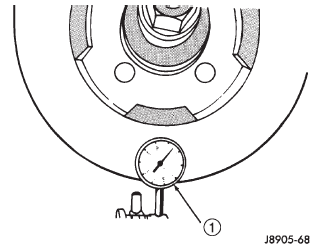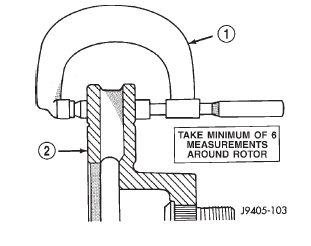Disc brake rotor. Brake drum
The rotor braking surfaces should not be refinished
unless necessary.
Light surface rust and scale can be removed with a
lathe equipped with dual sanding discs. The rotor
surfaces can be restored by machining in a disc brake
lathe if surface scoring and wear are light.
Replace the rotor under the following conditions: ROTOR MINIMUM THICKNESS Measure rotor thickness at the center of the brake
shoe contact surface. Replace the rotor if worn below
minimum thickness, or if machining would reduce
thickness below the allowable minimum.
Rotor minimum thickness is usually specified on
the rotor hub. The specification is either stamped or
cast into the hub surface. ROTOR RUNOUT Check rotor lateral runout with dial indicator
C-3339 (Fig. 7). Excessive lateral runout will cause
brake pedal pulsation and rapid, uneven wear of the
brake shoes. Position the dial indicator plunger
approximately 25.4 mm (1 in.) inward from the rotor
edge. Maximum allowable rotor runout is 0.102 mm
(0.004 in.).
1 - DIAL INDICATOR ROTOR THICKNESS VARIATION Variations in rotor thickness will cause pedal pulsation,
noise and shudder.
Measure rotor thickness at 6 to 12 points around
the rotor face (Fig. 8).
Position the micrometer approximately 25.4 mm (1
in.) from the rotor outer circumference for each measurement.
Thickness should not vary by more than 0.013 mm
(0.0005 in.) from point-to-point on the rotor. Machine
or replace the rotor if necessary.
1 - MICROMETER 2 - ROTOR The maximum allowable diameter of the drum
braking surface is indicated on the drum outer edge.
Generally, a drum can be machined to a maximum of
1.52 mm (0.060 in.) oversize. Always replace the
drum if machining would cause drum diameter to
exceed the size limit indicated on the drum. BRAKE DRUM RUNOUT Measure drum diameter and runout with an accurate
gauge. The most accurate method of measurement
involves mounting the drum in a brake lathe
and checking variation and runout with a dial indicator.
Variations in drum diameter should not exceed
0.069 mm (0.0028 in.). Drum runout should not
exceed 0.18 mm (0.007 in.) out of round. Machine the
drum if runout or variation exceed these values.
Replace the drum if machining causes the drum to
exceed the maximum allowable diameter.Disc brake rotor
 Fig. 7 Checking Rotor Runout And Thickness Variation
Fig. 7 Checking Rotor Runout And Thickness Variation Fig. 8 Measuring Rotor Thickness
Fig. 8 Measuring Rotor ThicknessBrake drum
Dodge Durango (DN) 1998-2003 Service Manual
- Lubrication and Maintenance
- Suspension
- Differential and Driveline
- Brakes
- Cooling System
- Battery
- Starting Systems
- Charging System
- Ignition System
- Instrument Panel Systems
- Audio Systems
- Horn Systems
- Speed Control System
- Turn Signal and Hazard Warning Systems
- Wiper and Washer Systems
- Lamps
- Passive Restraint Systems
- Electrically Heated Systems
- Power Distribution System
- Power Lock Systems
- Vehicle Theft/Security Systems
- Power Seat System
- Power Window Systems
- Power Mirror Systems
- Chime/Buzzer Warning Systems
- Overhead Console Systems
- Engine
- Exhaust System
- Frame and Bumpers
- Fuel System
- Steering
- Transmission and Transfer Case
- Tires and Wheels
- Body
- Heating and Air Conditioning
- Emission Control Systems
- Introduction
